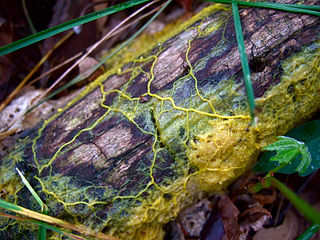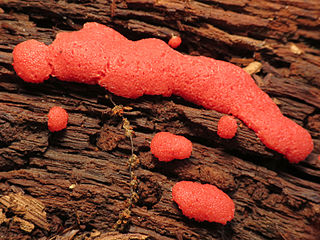Related Research Articles

Slime mold or slime mould is an informal name given to a polyphyletic assemblage of unrelated eukaryotic organisms in the Stramenopiles, Rhizaria, Discoba, Amoebozoa and Holomycota clades. Most are microscopic; those in the Myxogastria form larger plasmodial slime molds visible to the naked eye. The slime mold life cycle includes a free-living single-celled stage and the formation of spores. Spores are often produced in macroscopic multicellular or multinucleate fruiting bodies that may be formed through aggregation or fusion; aggregation is driven by chemical signals called acrasins. Slime molds contribute to the decomposition of dead vegetation; some are parasitic.

Physarum polycephalum, an acellular slime mold or myxomycete popularly known as "the blob", is a protist with diverse cellular forms and broad geographic distribution. The “acellular” moniker derives from the plasmodial stage of the life cycle: the plasmodium is a bright yellow macroscopic multinucleate coenocyte shaped in a network of interlaced tubes. This stage of the life cycle, along with its preference for damp shady habitats, likely contributed to the original mischaracterization of the organism as a fungus. P. polycephalum is used as a model organism for research into motility, cellular differentiation, chemotaxis, cellular compatibility, and the cell cycle.

Lycogala epidendrum, commonly known as wolf's milk or groening's slime, is a cosmopolitan species of myxogastrid amoeba which is often mistaken for a fungus. The aethalia, or fruiting bodies, occur either scattered or in groups on damp rotten wood, especially on large logs, from June to November. These aethalia are small, pink to brown cushion-like blobs. They may ooze a pink "paste" if the outer wall is broken before maturity. When mature, the colour tends to become more brownish. When not fruiting, single celled individuals move about as very small, red amoeba-like organisms called plasmodia, masses of protoplasm that engulf bacteria, as well as fungal and plant spores, protozoa, and particles of non-living organic matter through phagocytosis.

Brunfelsia pauciflora is a species of flowering plant in the family Solanaceae, the nightshades. It is endemic to Brazil, and it is grown in cultivation. A shrubby perennial plant grown in gardens, its common names include today, tomorrow together, yesterday, today and tomorrow, morning-noon-and-night, kiss me quick, and Brazil raintree.

Fuligo septica is a species of slime mold in the class Myxomycetes. It is commonly known as scrambled egg slime or flowers of tan because of its peculiar yellowish appearance. It is also known as dog vomit slime mold or Jasmine mold and is relatively common with a worldwide distribution, often being found on bark mulch in urban areas after heavy rain or excessive watering. Their spores are produced on or in aerial sporangia and are spread by wind.

Myxogastria/Myxogastrea or Myxomycetes (ICN) is a class of slime molds that contains 5 orders, 14 families, 62 genera, and 888 species. They are colloquially known as the plasmodial or acellular slime moulds.

Trichiales is an order of slime moulds in the phylum Amoebozoa. Trichiales is one of five orders in the group Myxomycetes, or the true plasmodial slime molds. It is also currently categorized under the superorder Lucisporidia with its sister group, Liceales. The order was first described by Thomas MacBride in 1922, and has retained the same name and status as a defined order in present phylogeny. In the plasmodium form, members of Trichiales lack a columella but have a well-developed capillitium for spore dispersal. The shape and details of the capillitium are used to define families within the order. Spores are brightly coloured, ranging from clear, white and yellow to pink and red-brown tones. The order currently has 4 families, 14 genera and 174 species. Recent molecular research has shown that while Trichiales probably represents a true taxonomic group, its sister group Liceales is likely paraphyletic, and it has been suggested that several genera from the Liceales should be reclassified under Trichiales instead.

Tubifera is a genus of slime moulds from the subclass Myxogastria. The genus comprises 12 species.

Brefeldia maxima is a species of non-parasitic plasmodial slime mold, and a member of the class Myxomycetes. It is commonly known as the tapioca slime mold because of its peculiar pure white, tapioca pudding-like appearance. A common species with a worldwide distribution, particularly in North America and Europe. It is often found on bark after heavy rain or excessive watering. Their spores are produced on or in aerial sporangia and are spread by wind, however beetles of the family Latridiidae are also reported to disperse the spores. Bonner states that soil invertebrates and rain mainly disperse spores as they are sticky and unlikely to be carried by air currents.

Willkommlangea reticulata is a slime mold species from the order Physarales and the only species of the genus Willkommlangea. It is common worldwide, but rare in Europe. The tropics are possibly the main area of habitat.

In true slime molds (myxogastria), lichens, and in species of the family Clavicipitaceae, the hypothallus is the layer on which the fruit body sits, lying in contact with the substrate. The word is derived from the Ancient Greek root hypó ("under") and thallós.

Trichia decipiens is a worldwide widespread slime mould species from the order Trichiida.
Prototrichia metallica is a slime mould species from the order Trichiida and the only species from the genus Prototrichia. It is mainly distributed on mountains.
Listerella paradoxa is a slime mould species from the class Myxogastria and the only member of its genus as well as the family Listerelliidae. The species is so far only found on the wattle genus Cladonia, mostly in European temperate zones.

Lindbladia tubulina is a slime mould species from the order Liceida and the only member of its genus.
Barbeyella minutissima is a slime mould species of the order Echinosteliales, and the only species of the genus Barbeyella. First described in 1914 from the Jura mountains, its habitat is restricted to montane spruce and spruce-fir forests of the Northern Hemisphere, where it has been recorded from Asia, Europe, and North America. It typically colonises slimy, algae-covered logs that have lost their bark and have been partially to completely covered by liverworts. The sporangia are roughly spherical, up to 0.2 mm in diameter, and supported by a thin stalk up to 0.7 mm tall. After the spores have developed, the walls of the sporangia split open into lobes. The species is one of the smallest members of the Myxogastria and is considered rare.

Hemitrichia is a genus of slime molds, of the family Trichiidae, found within the order Trichiida. It was first described by Josef Rostafinski in 1873 and remains a well-defined genus of the slime molds. Hemitrichia species exhibit either plasmodiocarp or sporangium fruiting bodies, both of which are well-known and recognizable slime molds seen on multiple continents. The genus includes Hemtrichia serpula, known as the pretzel slime mold, an iconic and widespread species that has been used to examine speciation in slime molds.

Diderma cinereum is a species of slime mould in the family Didymiaceae, first described by Andrew Price Morgan in 1894, from specimen(s) found in the Miami Valley on old wood and leaves.

Diderma effusum is a species of slime mould in the family Didymiaceae, first described by Lewis David de Schweinitz in 1832 as Physarum effusum, and transferred to the genus, Diderma, in 1894 by Andrew Price Morgan. It is found throughout the world, It feeds on nonliving organic matter.

Trichia crateriformis is a slime mold species in the order Trichiida found in temperate areas throughout the world.